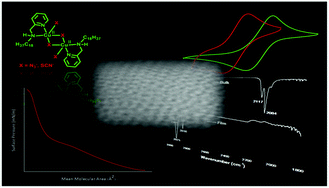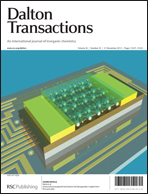In this paper we discuss the newly synthesized binuclear species [Cu2(LPY18)2(μ1,1-N3)2(N3)2] (1) and [Cu2(LPY18)2(μ1,3-SCN)2(NCS)2] (2), as obtained from the monometallic precursor [Cu(LPY18)Br2]. These gemini metallosurfactants incorporate metal/anion cascade cores and are investigated by experimental and theoretical methods. Diagnostic IR stretches support the presence of μ1,1-bridged (end-on, 2075 cm−1) azide groups in 1 and μ1,3-bridged (end-to-end, 2117 cm−1) thiocyanate groups in 2. Anion-to-copper LMCT electronic processes at 390 and 440 nm for 1 and at 415 nm for 2 reinforce the nature of the metal/anion cascade cores. Both species are redox-active, magnetically uncoupled due to poor orbital overlap, and robust in the presence of strongly coordinating solvents. At the air–water interface, 1 and 2 yield Langmuir films with high collapse pressures of ca. 60 mN m−1. Domain formation is considerably less extensive than that observed for the related monometallic precursor and the average molecular areas are in good agreement with their modeled molecular size. The resulting Langmuir–Blodgett films are isolated on silica substrates and investigated using IR-reflectance/absorbance spectroscopy.

You have access to this article
 Please wait while we load your content...
Something went wrong. Try again?
Please wait while we load your content...
Something went wrong. Try again?


 Please wait while we load your content...
Please wait while we load your content...